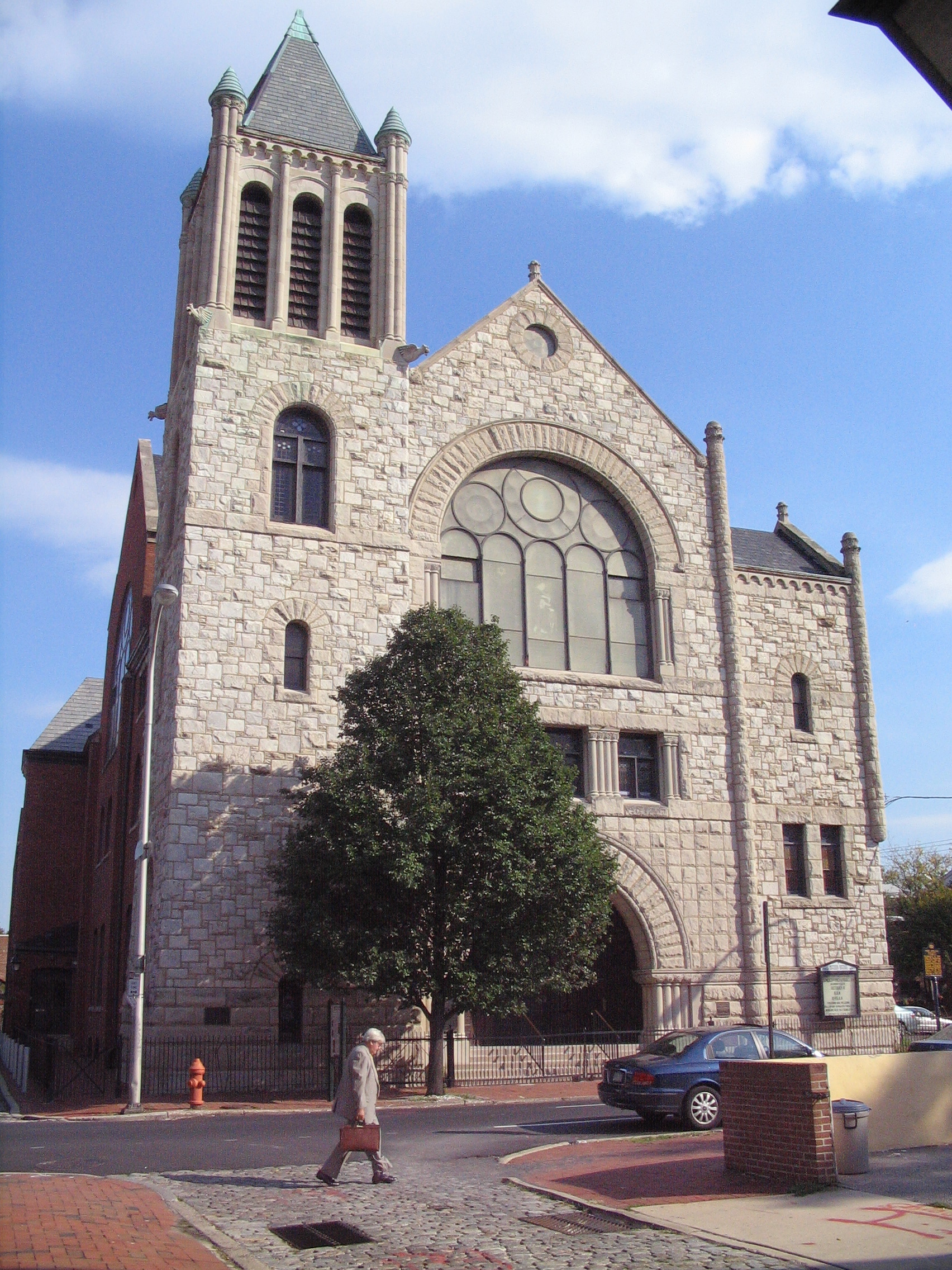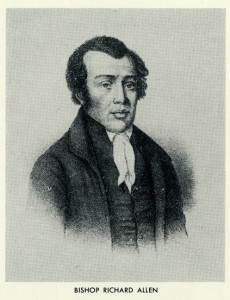Mother Bethel AME Church: Congregation and Community
By Ricardo Howell | Reader-Nominated Topic
Essay
Established in the crucible of the American revolutionary era, Mother Bethel African Methodist Episcopal Church is recognized as the genesis of Black religious organizing spirit. The church is mother church of the African Methodist Episcopal denomination, formed in 1816. Located at Sixth and Lombard Streets in Philadelphia’s Society Hill neighborhood, the church sits on the oldest continuously Black-owned parcel of land in the country. Mother Bethel was founded by Richard Allen, a Delaware-born former slave who purchased his own freedom in 1783 and began preaching the gospel in Delaware, Maryland, New Jersey, and Pennsylvania. In 1786 Allen was asked by a Methodist elder to minister to Philadelphia’s growing free Black community at the city’s St. George’s Church.
At St. George’s, Allen preached to Blacks at pre-sunrise services, so as not to get in the way of whites. He also evangelized Blacks in nearby neighborhoods. By 1787, Allen, ex-slave Absalom Jones, and other Black community leaders pressed to have a religious and social fellowship of their own. The causes of faith, mutual financial benefit, and community support were central to the Free African Society they formed in 1787. No less important were Black claims to personal and organizational independence in an age marked by slavery and liberty.
The preamble to Free African Society’s articles of incorporation paralleled the phrase that would become the preamble to the United States Constitution: “We, the free Africans and their descendants, of the City of Philadelphia…” Indeed, Allen and Jones’s generation lived in an era when the new nation accomplished its own liberation from England – notably with the aid of Black soldiers – but had left the majority of Blacks enslaved. From the onset, the Free African Society’s activist goals were to argue for the abolition of slavery, and to aid those free Blacks whose lives were compromised by the racial prejudices and proscriptions of the day. In practice, the Society’s members aimed to show themselves as valuable and trustworthy citizens. As one notable example, the Society ably filled the void as emergency health workers when yellow fever overran Philadelphia in 1793. Mother Bethel Church, the descendant of the Free African Society, recognizes its birth in the formative 1787 moment of first independent organization – a “Liberty Bell for Black folks” as one of the Church’s pastors has said.
A Church Walkout
Despite the religious activities undertaken by the Free African Society, its adherents remained as worshippers at St. George’s until the early 1790s. With their numbers rising – and with tensions rising with white congregants – Richard Allen and Absalom Jones and other Blacks began fundraising and petitioned Methodist elders to create a distinct Black church. Although their designs were denied, confrontation was inevitable. When whites at St. George’s attempted to push Blacks to segregated seating and physically bar them from kneeling in prayer during a Sunday service, Allen and Jones led Black parishioners in a walkout.
Three Black congregations originate from this historic act of protest. Some Blacks preferred to associate themselves with the Episcopal (formerly Anglican) denomination –founding St. Thomas’s African Episcopal Church, with Jones as their leader in 1794. Black congregants who remained at St. George’s were soon allowed to meet separately and would formally organize African Zoar Methodist Church, a Methodist satellite, in 1796. Allen, who believed deeply in the Methodism’s antislavery bona fides and its virtues of plain living and speaking, remained committed to establishing an independent Methodist church. On land located at Sixth and Lombard Streets that Allen had purchased in 1791, Bethel Church was dedicated in July 1794. The church remains at this location today, hence its claims to the oldest continuously Black-owned plot of land in the country.
Among the churches formed in the wake of the walkout Allen’s Bethel Church was highly active, organizing the first Black Sunday school – and perhaps a separate night school – in 1795. Mother Bethel led in moral leadership, as well, with Allen shepherding and instructing newly liberated and free alike in rectitude. Allen’s method was to prove that Blacks were fit for equality – while they took the moral high ground and action against discrimination. He, along with Jones and others, petitioned Congress in 1799 to end the African slave trade well before its constitutionally possible 1808 expiration date, and to take action to free Blacks who remained in bondage. By the 1810s, Bethel claimed greater than 1,000 members. Allen and Bethel’s efforts went beyond Black self-help; during the War of 1812, Bethel helped to raise 2,500 Black troops in the efforts against the British.
“Abbey of African Methodism”
In the antebellum era, Bethel’s reach spread throughout the republic. In 1816 Allen solidified a regional network of churches in an act that would transform Bethel into the “abbey of African Methodism.” Delegates from five churches in Baltimore, Washington, Wilmington, Philadelphia, and Salem, New Jersey, whose experiences with white Methodist parent churches were similar, agreed to ally in a new denomination, the African Methodist Episcopal (AME) “connection” with Richard Allen elected the organization’s first bishop. The seed of religious independence that was sowed in 1787 and germinated in 1794 grew quickly in the first five years of the AME denomination’s emergence, absorbing congregations in New York, New Jersey, Pennsylvania, and Maryland. Evangelists with talents like Richard Allen’s were tasked with organizing AME congregations in Ohio and parts of the emerging West.
If Bethel was mother church of the burgeoning AME connection, it was also a beacon to the still-enslaved, serving as a Philadelphia sanctuary along the “Underground Railroad” to freedom. And in 1830 Allen, who had long helped shape conversations about the destiny of Blacks in America – including the merits of African colonization – oversaw the planning of the first national meeting of Black leaders. Delegates to the convention, the American Society of Free Persons of Color, met for five days in September 1830 at Bethel Church. This would be Allen’s final act before his death in 1831, but it reflected only a portion of his legacy.
By the time of Allen’s death, the AME Church had congregations in every northern state and several southern states with 10,000 members. By the Civil War, AME membership was two to five times that size, according to various estimates. During and after the war, ministers who were Richard Allen’s successors moved like dynamos through the South and the West, founding churches, promoting Black involvement in politics, and establishing a growing roster of AME higher education institutions and an increasing set of departments and missions. By 1900, the AME Church was a sprawling denomination with churches in places as far-flung (from Philadelphia) as South Africa. In the second half of the 1800s, Bethel could tout its leaders like journalist and activist Frances Ellen Watkins Harper or famed educator Fannie Coppin. Mother Bethel was still the AME Church’s home. Philadelphia was still its headquarters. The denomination, however, had several focal points by this juncture.
Mother Bethel and the Seventh Ward
The trends affecting Mother Bethel’s development in the first half of the twentieth century were firmly in place by the early 1900s. Philadelphia’s mid-nineteenth-century municipal consolidation opened up areas west and north of the existent city. Growing industrialization provided jobs for whites, but not many for Blacks, if any. Instead, waves of African Americans, particularly former slaves and their descendants, were drawn to opportunity in Philadelphia, and found work only in domestic service or other manual labor. As a matter of familiarity, necessity, and discrimination against their choice in housing, Blacks who migrated were funneled into the city’s most aging housing stock, often into overcrowded conditions, including the Seventh Ward neighborhood surrounding Mother Bethel.
The Seventh Ward was particularly worrisome to Philadelphia’s social reformers. At the turn of the century, sociologist W. E. B. Du Bois observed “the best of the great laboring classes” among Bethel’s congregation. Empowered by its members, Bethel was able to construct its current structure in the late 1880s. When Du Bois arrived in Philadelphia to being his study of the Seventh Ward, Bethel claimed the most members of fourteen AME congregations in the city. An influx of Black migrants to Philadelphia expanded many of the city’s churches and denominations. Mother Bethel was no different, welcoming Blacks from Georgia and South Carolina. Mother Bethel played an important part in encouraging such migration by sending southward information about conditions in Philadelphia and promising a church home to Black southerners arriving in the city. But the influx of newcomers to the church, as in other established congregations, also created tensions between the more staid worship service and leadership in the church and the “country” ways of the rural Blacks coming into the city. Such tensions contributed to some church members leaving to join other congregations.
Between 1890 and 1930, many churches were established in or moved to the north or west parts of the city. During the 1920s, some at Mother Bethel considered moving the historic church but decided against it. Instead, Mother Bethel remained in its current location as many residents moved or were moved out.

As a testament to the vitality of the institution, Bethel paid off its debt in 1945. The church was designated a historic shrine by the Department of the Interior in 1965, and a historic landmark in 1974. Mother Bethel’s efforts to create a museum detailing its history led to the 1976 establishment of the African American Museum of Philadelphia – in time for the nation’s bicentennial. In a story that parallels Mother Bethel’s origins, white residents of the church’s Society Hill neighborhood, and Black residents from other sections of the city, fought against an effort to have a Black history museum erected adjacent to the church.
In the twenty-first century a renovated Mother Bethel symbolizes Richard Allen and the AME legacy of pressing for religious, economic, and social freedom. Among those who have graced the church and spoken from its pulpit are freedom fighters Desmond Tutu, the South African archbishop in 1986, and in 1995 Rosa Parks, a pioneer of the modern civil rights movement. The AME Church that has grown up around Mother Bethel is a sprawling international conference of churches, with 7,000 places of assembly and more than four million members. Mother Bethel is one of more than two dozen AME churches in Philadelphia in the AME’s First District Conference, headquartered since 1986 in West Philadelphia. As W. E. B. Du Bois observed, the “growth of Bethel Church…has been so phenomenal that it belongs to the history of the nation rather than to any one city.” (Author information current at time of publication.)
Copyright 2009, University of Pennsylvania Press
Gallery
Backgrounders
Connecting Headlines with History
Links
- Legacy of Courage: W.E.B. DuBois and the Philadelphia Negro
- Richard Allen and the Founding of Mother Bethel AME Church (PhillyHistory.org Blog)
- PhilaPlace: Mother Bethel African Methodist Church (Historical Society of Pennsylvania)
- Richard Allen: Apostle of Freedom (Digital Exhibit, Historical Society of Pennsylvania and Library Company of Philadelphia)


